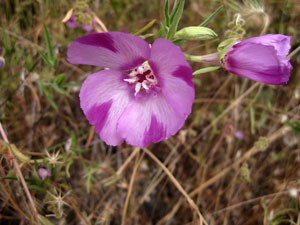Resource Library
Plant of the Week: Farewell to Spring
The University of Arkansas System Division of Agriculture does not promote, support or recommend plants featured in "Plant of the Week." Please consult your local Extension office for plants suitable for your region.
Plant of the Week
Farewell to Spring
Latin: Clarkia amoena

Having just returned from a pilgrimage to the American West, I’m all pumped after seeing the wildflowers of that far and distant land. Generalizing about such a vast region is impossible, but generally the plants that grow there usually must endure limited rainfall, especially during the long, dry summers. One plant of the region, Farewell to Spring (Clarkia amoena), has been grown in eastern gardens as a springtime annual.
Farewell to Spring is one of 41 species of Clarkia found in the Western parts of North America and in Pacific coast regions of South America. All species are annual herbs of the evening primrose family. Clarkia amoena is found in dry, often rocky grasslands and at the edge of forests in the Coastal and Cascade Range from Northern California to Washington.
Farewell to Spring grows 16 to 24 (to 36 inches in some hybrids) inches tall with an erect but sprawling habit with little lateral branching. Its simple leaves are 1 to 2 inches long, lanceolate and arranged alternately up the stem. Blooms are produced terminally in a congested leafy spike in late spring into early summer. Individual flowers are to 2 inches across with four equally sized petals arranged in a cuplike fashion. Flower color is usually in shades of pink, usually with a pronounced lavender blotch on each petal.
Clarkia, often listed in older references under the obsolete name Godetia amoena, is named after William Clark (1770-1838) of Lewis and Clark fame. Clark County is also named after this explorer. The epitaph “amoena” translates from Latin as pleasant or delightful..
The genus was established and named for Clark by a German botanist, Frederick Pursh, who published his Latin treatise “Flora Americae Septentrionalis” in 1814 in London. Pursh spent about a decade in the United States working and collecting plants. In 1807, a year after the return of the expedition, Meriwether Lewis gave 132 pressed and dried plant specimens to Pursh, along with $70, and instructions for Pursh to work up botanical descriptions of the plants so Lewis could include them in the publication of the official report of the trip.
In 1811, Pursh traveled to London, taking with him the expedition’s plant specimens, and began working on his book, feeling no need to honor his commitment to Lewis, who had died two years earlier. Of the 132 plants, only a few were known to science, so Pursh assigned new species status to 94 of them, 40 of which are still recognized as valid. As a happy side note, the herbarium specimens returned to the United States (the Philadelphia Academy of Natural Sciences) in 1856 when a visiting Harvard graduate (Edward Tuckerman) purchased the collection while visiting London.
Clarkia is most often grown as a spring bedding plant for used in mixed borders and rock gardens. It can be seeded directly, where it is to grow with seeds lightly raked into the soil in March. Occasionally, bedding plants are offered. Because it grows early in the season, bedding plants should be planted as soon as possible after the last freeze date. Hybrids of several Clarkia species are now grown commercially as cut flowers, where they often are sold as Godetia or Satin Flowers.
By: Gerald Klingaman, retired
Retired Extension Horticulturist - Ornamentals
Extension News - July 15, 2011
The University of Arkansas System Division of Agriculture does not maintain lists of retail outlets where these plants can be purchased. Please check your local nursery or other retail outlets to ask about the availability of these plants for your growing area.